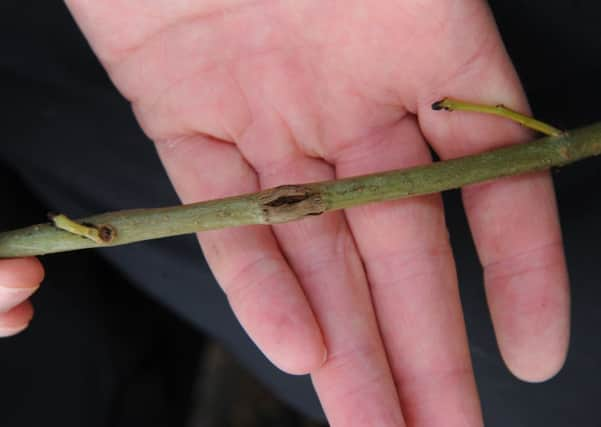Warning over spread of ash dieback in Scotland


The chalara infection causes leaf loss and crown dieback, with repeated infection usually leading to tree death.
It was first detected in Scotland in the summer of 2012, with 23 cases confirmed by November last year.
Advertisement
Hide AdAdvertisement
Hide AdIt has now been found at 95 recently planted sites, three nurseries and 17 spots in the wider environment, according to Forestry Commission Scotland figures.
The infection is spread by the movement of young ash plants and by airborne spores. It was initially found in the UK in planted stock at nurseries and it is thought that spore plumes are also likely to have reached the east of the country from Europe.
Conservationists say the apparent increase in Scottish cases over the last year could be partly due to increased survey coverage and under-reporting of the disease in the early stages because it can be difficult to spot. Nevertheless, it is present in Scotland and is spreading.
Tim Hall, operations manager at the Woodland Trust Scotland, said: “The current view is that it spreads through the wind about 20 to 30km per year and it clearly is spreading in Scotland. It’s always hard to say whether there are more cases because people are more aware of it and are identifying cases more readily.
“But without a doubt it is spreading and one can only expect exponential growth as more trees become infected.”
Hugh Clayden, tree health policy adviser for Forestry Commission Scotland, said: “The best you can hope for is to try and buy some time by slowing down the spread, but there will be an inexorable movement of the disease through Scotland, I think that’s fairly clear from the European experience.”
Despite the apparent rise in the number of cases seen in Scotland, the pace of its spread does not seem to have been as fast as was feared. The relatively dry summer may have helped delay the progress of the disease, experts say.
Forestry consultant Richard Worrell said: “My expectation for 2013 was we were going to find it much more widely, but we haven’t. What we’re pretty sure is going on is that it’s not obvious enough for people out in the woods.
“It’s going to take some time to really manifest itself.”
Advertisement
Hide AdAdvertisement
Hide AdEfforts to reduce the impact of ash dieback are mainly concentrated on a vast sheltered area of north-west Scotland which has so far escaped the full impact of the disease.
Mr Clayden said: “In the north-west of Scotland we have the best chance of slowing down its arrival and spread by taking statutory action to remove infected young trees. There’s far less risk in the early stages of getting spores blown in from elsewhere.”
Reports from some European countries also point to up to 25% of ash trees still remaining relatively healthy, despite a high incidence of the disease, although longer-term survival prospects may yet drop to 5% or less.
But experts warn chalara is just one of several potentially devastating diseases threatening Scotland’s forests as a consequence of global trade and possibly climate change.
The fungal disease dothistroma needle blight, which can cause severe damage to and death of many pine species, is now present throughout Scotland, including on Scots pine, leading to concerns it may yet threaten unique Caledonian pinewoods.
Phytophthora ramorum is killing larch trees and other plants particularly in the wetter west of Scotland, while the fungus-like pathogen Phytophthora austrocedrae is attacking Scotland’s juniper.
The emerald ash borer, an invasive species of beetle, has already killed millions of ash trees in the USA and is now making its way west from Moscow.
Dr Worrell said: “Ash dieback is only one of a number of diseases we’re dealing with at once that have all appeared in a relatively short time.
Advertisement
Hide AdAdvertisement
Hide Ad“Personally, I regard it as the big environmental issue. I don’t think we’ve been faced with a situation quite as serious as this. In most of these diseases, the primary causal factor is people moving organisms around the globe in trade.”
Mr Hall said people could do their bit to slow the spread of disease by cleaning the mud off their boots and bikes when they return home from a woodland trip, but he called for greater public awareness of the threats facing Scotland’s forests.
He said: “I think we need to get, as a society, more aware of the plants we buy for the garden or the house. Where have they come from, do we really need to buy plants that have been grown overseas and may bring diseases with them?”
SEE ALSO